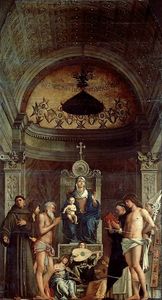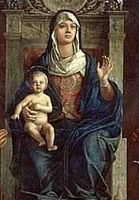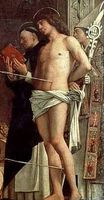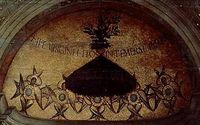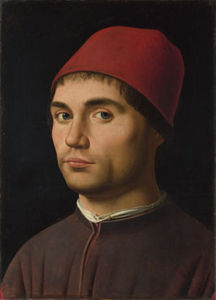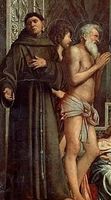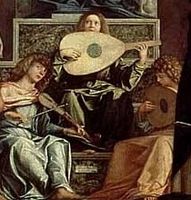San Giobbe Altarpiece Analysis
- Date of Creation:
- 1487
- Alternative Names:
- Enthroned Madonna, Enthroned Madonna with Saints
- Height (cm):
- 471.00
- Length (cm):
- 258.00
- Medium:
- Oil
- Support:
- Wood
- Subject:
- Figure
- Art Movement:
- Renaissance
- Created by:
- Current Location:
- Venice, Italy
- Displayed at:
- Gallerie dell'Accademia
- Owner:
- Gallerie dell'Accademia
- San Giobbe Altarpiece Analysis Page's Content
- Composition
- Use of Light
- Technical innovations
- Miscellaneous
San Giobbe Altarpiece Composition
Bellini composed this image as a sacra conversazione, or holy conversation, between the Virgin Mary and Christ Child, three angels, St. Job, St. John the Baptist, St. Dominic, St. Sebastian, St. Francis of Assisi and St. Louis, Bishop of Toulouse.
There are eleven figures depicted here in a well-balanced, almost completely symmetrical composition. All the figures except the Virgin and Child are grouped in threes - perhaps a nod toward the Holy Trinity - with the saints on either side of the throne arranged in opposite-facing triangular shapes so as to make the arrangement look more natural and less rigid.
The three musical angels are sitting so that their general shape points upward toward Mary and Jesus in a subtle arrow.
Although Mary and Jesus are only a pair instead of a trio, this makes them even more prominent and heightens their importance. But it can also suggest that another figure could be missing from the image. St. Francis' outstretched hand beckons the viewer closer, perhaps to fill the void. Or perhaps it is meant to be understood the God is the third entity that would complete a trio with Mary and the Christ Child.
The figures are all in the lower half of the painting, with the upper half occupied by a stunning display of architectural rendering. Bellini crafted a vaulted ceiling, a gilded dome and carved marble columns with oil paints alone, creating a convincing extension of the church itself.
Because it looks like a natural setting - people standing in a group on the floor of a church - the image is balanced and not bottom heavy. The luminous golden color of the dome contributes to the balance as well, preventing the top of the painting from being too dark compared to the relatively colorful bottom.
San Giobbe Altarpiece Use of Light
Bellini was a master of light and he used light and shadows to create images that were more life-like and emotionally evocative than many of his contemporaries could begin to attempt. In the San Giobbe Altarpiece, Bellini used the angle of the church's own windows as the source for his light, further adding to the painting's realism and the illusion that it is an actual extension of the church.
The light Bellini floods this image with is warm and expertly molded in a way that adds depth to the painting itself and a depth of feeling to the figures depicted. Mary is the only figure who meets the light head-on with her steady gaze, which not only illuminates her entire face, but hints at the light being a source of spiritual strength for her.
The light also prominently illuminates Jesus, who is entirely bathed in a soft glow. This, naturally, is reminiscent of the Biblical words proclaiming that Jesus is the light of the world.
In the top of the painting, the gilded dome is lined with a half-ring of angels inscribed with "Ave, gratia plena" meaning "Hail, full of grace" and a larger circling inscription that reads "Ave Virginei Flos Intemerate Pudoris," meaning "Hail, undefiled flower of virgin modesty. "
Bellini positioned the light in the painting to delicately glitter within the dome and highlight this message that actually has a double meaning. The city of Venice itself invokes the Virgin as its patron and protector since the city was officially founded on the Feast of Annunciation (when God revealed to Mary that she would give birth to Jesus). Thus, Bellini was able to cleverly and subtly work in his passion for his city while honoring the Mother of God.
San Giobbe Altarpiece Technical innovations
Oil painting:
During much of his career, Bellini studied the artistic style of Northern European artists, such as Jan van Eyck, who used oil paints to create softer images filled with vibrantly blended colors. Bellini must have been eager to experiment with this new style of painting, because when he met the Sicilian painter Antonello da Messina in the mid-1470s - who is credited with disseminating oil painting techniques throughout Italy - he adopted oil paints over tempera paints almost exclusively.
Oil paints allowed skilled artists like Bellini to deliver extremely life-like images through the creation of seamlessly blended shadows and highlights. These are essential for creating the illusion of three-dimensional forms on a two-dimensional panel. Unlike the older style tempera paints, oil paints are much more slow-drying, which allows the painter to layer and blend colors to make images pop.
With a relatively small color palette and deftly weaving colors together with half tones, Bellini was able to use the properties of oil paints to create a warm and expressive depiction of these holy figures.
San Giobbe Altarpiece Miscellaneous
Symbolism of the Subjects:
Mary and Jesus:
The Virgin - clothed in luscious cobalt robes - and a naked baby Jesus occupy a decorative marble throne at the center of the altarpiece. The throne, both in this image and others similar to it, is often believed to be evocative of the throne of King Solomon and his wisdom. Mary gazes toward the painting's unseen source of light, with her left arm raised and palm open toward the parishioners. Her right hand supports the infant Jesus, who gazes up and slightly away from the light source, possibly looking toward heaven.
St. Francis of Assisi:
To the left of the painting and at Mary's right-hand side are St. Francis of Assisi, St. John the Baptist, and St. Job.
St. Francis, the founder of the widely popular Franciscan Order, is clothed in his traditional brown hooded cloak and his outstretched right hand beckons those viewing the painting to join the holy conversation. His left hand, crossed over his chest, displays his stigmata wound and spear wound, reflecting the sacrifice the child seated on Mary's lap will one day suffer.
John the Baptist:
Behind St. Francis, the bearded St. John the Baptist appears somewhat unkempt and gazes lovingly at Jesus. Nearest to the throne is Job, the namesake of both the church and the confraternity that commissioned the altarpiece. He is clothed only in a loincloth and maintains a prayerful posture with hands raised, head level, and pleading eyes.
St. Job:
The church's namesake occupies a place of extreme honor at the right hand of the Virgin and Christ. His prayerful posture indicates his unfaltering devotion to God, even in light of the immense suffering he endured. Unlike other images of Job, the one that Bellini has painted depicts the saint free from the boils he was plagued with, perhaps not wanting something so earthly to mar his heavenly gathering.
Trio of Angels:
Directly beneath Mary and Jesus, seated at the steps of the throne are three angels playing intricately portrayed string instruments. Two angels watch St. Job, almost as if taking cues from him, a patron saint of music. The presence of the angels and their silent music harkens to the city of Venice's preference for sensual pleasures over scholarly ones.
St. Dominic:
On the right side of the painting are St. Dominic - founder of the Dominican Order - St. Sebastian and St. Louis. St. Dominic is deeply engrossed in a red leather-bound Bible to symbolize the Dominican Order's emphasis on careful intellectual study and understanding of the Bible. This order of friars is famous for producing respected philosophers and theologians.
St. Dominic gracefully juxtaposes St. Francis - both are founders of well-respected Catholic orders but each has distinct characteristics. While Dominic presents a somewhat closed and concentrating countenance, Francis is more open and wistful, perhaps because his was a life that more Venetians could relate to, rather than a life filled with fastidious study.
St. Sebastian:
St. Sebastian was a popular figure in Renaissance art and was commonly depicted as a man bound and littered with arrows. The St. Sebastian Bellini portrayed here, however, seems placid and unbothered by the two arrows (a mere two arrows compared with other renditions) piercing his body. His arms are even relaxed and seem almost willingly bound behind him.
St. Sebastian's youth and even his posture is juxtaposed against St. Job's, who is aged and whose hands are in front rather than behind him. St. Sebastian even leans back while St. Job bends forward. Sebastian's hair is brown and his face clean-shaven, while Job couldn't be more opposite with thinning white hair and a cascading beard.
Both men, however, are clothed similarly and their bodies are nearly free from marks, even though Job suffered from gruesome boils and Sebastian was riddled with arrows. Bellini evidently did not want the suffering endured by his subjects to infiltrate the beauty he was trying to create.
St. Louis:
Originally a prince from the House of Anjou, St. Louis renounced his claim to the throne of Naples and sought a life in the church by becoming a Franciscan friar and eventually the Bishop of Toulouse. He holds an elaborate golden crosier, which is juxtaposed by John the Baptist's barely visible rustic twig cross.
Bellini also included a miniature image of St. Job - a mirror-image of his stance in the larger painting - woven within St. Louis' robes as a further way to honor the saint who lent his name to the church and commissioning confraternity.

